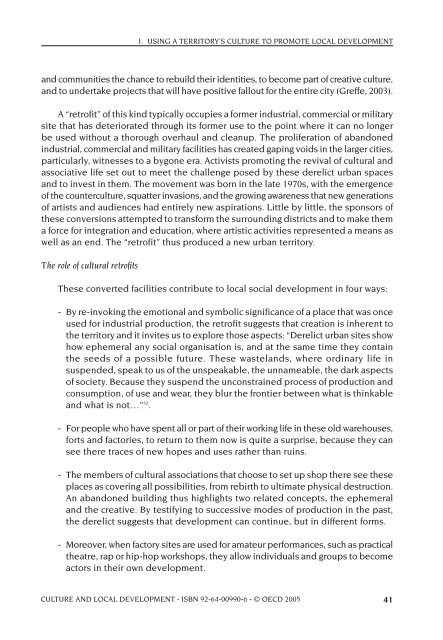OECD Culture and Local Development.pdf - PACA
OECD Culture and Local Development.pdf - PACA
OECD Culture and Local Development.pdf - PACA
You also want an ePaper? Increase the reach of your titles
YUMPU automatically turns print PDFs into web optimized ePapers that Google loves.
1. USING A TERRITORY’S CULTURE TO PROMOTE LOCAL DEVELOPMENT<br />
<strong>and</strong> communities the chance to rebuild their identities, to become part of creative culture,<br />
<strong>and</strong> to undertake projects that will have positive fallout for the entire city (Greffe, 2003).<br />
A “retrofit” of this kind typically occupies a former industrial, commercial or military<br />
site that has deteriorated through its former use to the point where it can no longer<br />
be used without a thorough overhaul <strong>and</strong> cleanup. The proliferation of ab<strong>and</strong>oned<br />
industrial, commercial <strong>and</strong> military facilities has created gaping voids in the larger cities,<br />
particularly, witnesses to a bygone era. Activists promoting the revival of cultural <strong>and</strong><br />
associative life set out to meet the challenge posed by these derelict urban spaces<br />
<strong>and</strong> to invest in them. The movement was born in the late 1970s, with the emergence<br />
of the counterculture, squatter invasions, <strong>and</strong> the growing awareness that new generations<br />
of artists <strong>and</strong> audiences had entirely new aspirations. Little by little, the sponsors of<br />
these conversions attempted to transform the surrounding districts <strong>and</strong> to make them<br />
a force for integration <strong>and</strong> education, where artistic activities represented a means as<br />
well as an end. The “retrofit” thus produced a new urban territory.<br />
The role of cultural retrofits<br />
These converted facilities contribute to local social development in four ways:<br />
- By re-invoking the emotional <strong>and</strong> symbolic significance of a place that was once<br />
used for industrial production, the retrofit suggests that creation is inherent to<br />
the territory <strong>and</strong> it invites us to explore those aspects: “Derelict urban sites show<br />
how ephemeral any social organisation is, <strong>and</strong> at the same time they contain<br />
the seeds of a possible future. These wastel<strong>and</strong>s, where ordinary life in<br />
suspended, speak to us of the unspeakable, the unnameable, the dark aspects<br />
of society. Because they suspend the unconstrained process of production <strong>and</strong><br />
consumption, of use <strong>and</strong> wear, they blur the frontier between what is thinkable<br />
<strong>and</strong> what is not…” 32 .<br />
- For people who have spent all or part of their working life in these old warehouses,<br />
forts <strong>and</strong> factories, to return to them now is quite a surprise, because they can<br />
see there traces of new hopes <strong>and</strong> uses rather than ruins.<br />
- The members of cultural associations that choose to set up shop there see these<br />
places as covering all possibilities, from rebirth to ultimate physical destruction.<br />
An ab<strong>and</strong>oned building thus highlights two related concepts, the ephemeral<br />
<strong>and</strong> the creative. By testifying to successive modes of production in the past,<br />
the derelict suggests that development can continue, but in different forms.<br />
- Moreover, when factory sites are used for amateur performances, such as practical<br />
theatre, rap or hip-hop workshops, they allow individuals <strong>and</strong> groups to become<br />
actors in their own development.<br />
CULTURE AND LOCAL DEVELOPMENT - ISBN 92-64-00990-6 - © <strong>OECD</strong> 2005 41














